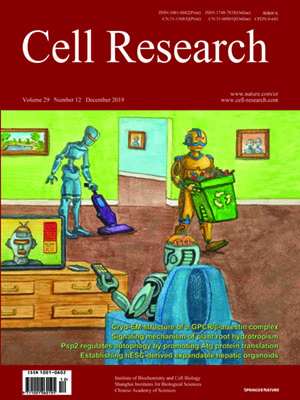
Volume 29, No 12, Dec 2019
ISSN: 1001-0602
EISSN: 1748-7838 2018
impact factor 17.848*
(Clarivate Analytics, 2019)
Volume 29 Issue 12, December 2019: 1009-1026
ORIGINAL ARTICLES
Human ESC-derived expandable hepatic organoids enable therapeutic liver repopulation and pathophysiological modeling of alcoholic liver injury
Shuyong Wang 1,2, Xuan Wang 1,3, Zuolong Tan1, Yuxin Su1, Juan Liu 1,4, Mingyang Chang1, Fang Yan1, Jie Chen5, Tao Chen5,Chuanjiang Li6, Jie Hu3 and Yunfang Wang 1,4
1Tissue Engineering and Regenerative Medicine Lab, Beijing Institute of Health Service and Transfusion Medicine, 100850 Beijing, China; 2Army Tuberculosis Prevention and Control Key Laboratory, Beijing Key Laboratory of New Techniques of Tuberculosis Diagnosis and Treatment, Institute of Tuberculosis Research, The 8th Medical Center of Chinese PLA General Hospital, 100091 Beijing, China; 3Department of Nursing, Hebei Medical University, 050017 Shijiazhuang, China; 4Hepatal-Biliary-Pancreatic Center, Translational Research Center, Beijing Tsinghua Chang Gung Hospital, 102218 Beijing, China; 5Department of Hepatobiliary Surgery, Sun Yat-sen Memorial Hospital, Sun Yat-sen University, 510289 Guangzhou, China and 6Department of Hepatobiliary Surgery, Nanfang Hospital, Southern Medical University, 510515 Guangzhou, China
Correspondence: Yunfang Wang (wangyf1972@gmail.com)These authors contributed equally: Shuyong Wang, Xuan WangThese authors are co-senior authors: Jie Hu, Yunfang Wang
We report the generation of human ESC-derived, expandable hepatic organoids (hEHOs) using our newly established method with wholly defined (serum-free, feeder free) media. The hEHOs stably maintain phenotypic features of bipotential liver stem/progenitor cells that can differentiate into functional hepatocytes or cholangiocytes. The hEHOs can expand for 20 passages enabling large scale expansion to cell numbers requisite for industry or clinical programs. The cells from hEHOs display remarkable repopulation capacity in injured livers of FRG mice following transplantation, and they differentiate in vivo into mature hepatocytes. If implanted into the epididymal fat pads of immune-deficient mice, they do not generate non-hepatic lineages and have no tendency to form teratomas. We further develop a derivative model by incorporating human fetal liver mesenchymal cells (hFLMCs) into the hEHOs, referred to as hFLMC/hEHO, which can model alcoholic liver disease-associated pathophysiologic changes, including oxidative stress generation, steatosis, inflammatory mediators release and fibrosis, under ethanol treatment. Our work demonstrates that the hEHOs have considerable potential to be a novel, ex vivo pathophysiological model for studying alcoholic liver disease as well as a promising cellular source for treating human liver diseases.
https://doi.org/10.1038/s41422-019-0242-8
FULL TEXT | PDF
Browse 1159


